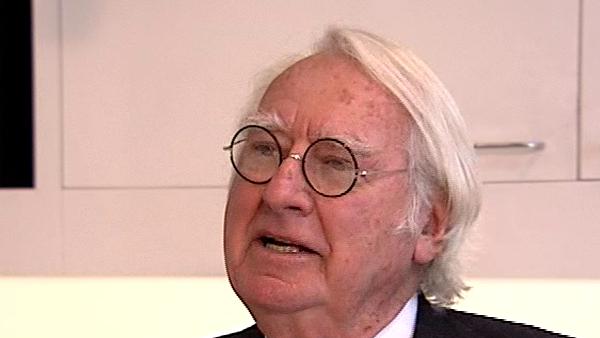NEXT STORY

My children: a designer and a sculptor
RELATED STORIES

NEXT STORY

My children: a designer and a sculptor
RELATED STORIES


|
Views | Duration | |
|---|---|---|---|
| 31. A global playing field for architects | 123 | 06:50 | |
| 32. Architectural critics | 131 | 06:20 | |
| 33. The next generation of architects | 149 | 03:21 | |
| 34. My children: a designer and a sculptor | 221 | 01:05 | |
| 35. Meeting the Pope | 136 | 04:55 | |
| 36. The state of architecture today | 167 | 02:35 |

Well I think that in a lot of... a lot of the things that we’ve been talking about have influenced the younger generation of the last, say, 20 years. The books, the... the combination of practice and theory, the interest and... and I think attitude. You know, when... when I was in architecture school, for the most part and most of the people I know, you know, when you graduated you went into architecture. For many young people today they stay... either stay in school or teach. A lot of people stay, sort of, in academia, as it were, for a longer period of time and therefore I guess they’re not as much in a rush to go into practice. And are also looking at other areas in which they can work as an architect rather than traditional practice. So, I think that that, sort of, in a sense, affects the young people and I think that all the influences, you know, from both the schools and the publications influence, you know, influence the work that’s being done by young architects. And sort of the blip that we talked about, that occurred in the '80s, you know, they don’t even... they don’t even know about it. I mean it’s like it doesn’t exist, you know, it’s not part of their educational experience. I mean it’s, sort of, like what’s happening now is more of an influence on them.
[Q] However, a lot of the teachers grew up during that blip, unfortunately, and have an influence today in that lack of... how can I say? Lack of redaction.
Yeah. I don't... I mean I only know the places where I've gone to lecture and seen their work. So... someone in the office just did a slide show of what she was teaching when she was at the University of Florida. You know, it was terrific, abstract exercises in making of space and, you know, very, very good. So I don't see where she was influenced, at least by...
The prominent American architect Richard Meier (b. 1934) is best known for the Getty Centre in Los Angeles, one of his many public projects which broke from his usual style of sleek, white buildings. In all his work – carried out with characteristic refined style – he refuses to bend to the trends of modern architecture. He has won many awards including the Pritzker Prize for Architecture, considered the field's highest honour.
Title: The next generation of architects
Listeners: Massimo Vignelli
Massimo Vignelli was born in Milan and studied architecture in Milan and Venice. He is the co-founder and President of Vignelli Associates and Chief Executive Officer of Vignelli Designs in New York. His work includes graphic and corporate identity programs, publication designs, architectural graphics, interiors, furniture, and consumer product designs. His work has been published and exhibited throughout the world and entered in the permanent collections of several museums. He has taught and lectured on design in the major cities and universities in the United States and abroad. Included among Massimo Vignelli's awards are the Gran Premio Triennale di Milano, 1964, the Compasso d'Oro, awarded by the Italian Association for Industrial Design (ADI), 1964 and 1998, the 1982 Art Directors Club Hall of Fame, the 1983 AIGA Gold Medal, the 1992 Interior Product Designers Fellowship of Excellence, The 1995 Brooklyn Museum Design Award for Lifetime Achievement and The 2001 Russel Wright Award for Design Excellence.
Duration: 3 minutes, 21 seconds
Date story recorded: March 2007
Date story went live: 23 December 2008